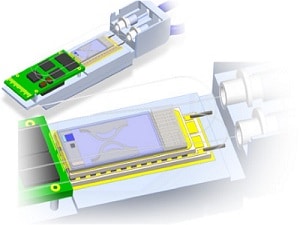Enables low-cost and small 100G CWDM4 Optical Engine while including photodiodes and features supporting a self-aligned fibre attach unit
 POET Technologies has announced that it has completed and tested its high-speed Directly Modulated Laser (DML) designs using a distributed feedback (DFB) structure and successfully “flip-chipped” these lasers onto the Company’s Optical Interposer platform, which also incorporates several other industry-first accomplishments.
POET Technologies has announced that it has completed and tested its high-speed Directly Modulated Laser (DML) designs using a distributed feedback (DFB) structure and successfully “flip-chipped” these lasers onto the Company’s Optical Interposer platform, which also incorporates several other industry-first accomplishments.
The flip-chip assembly technique enables a true single-chip, fully integrated Optical Engine to be produced at wafer-scale, resulting in a low-cost, small-size 100G CWDM4 Optical Engine with a form factor of 9mm x 6mm, while including banks of four lasers, four monitor photodiodes, four high-speed photodiodes, a multiplexer, demultiplexer, taps for power monitoring and features supporting a self-aligned fibre attach unit.
“Without being able to flip-chip the lasers, we would be unable to assemble Optical Engines at wafer-scale, which is the single most important driver of cost. Wafer-scale processing enables the production of high unit volumes at low incremental costs, ultimately allowing us to reduce the cost of building photonics devices by 25% to 40% compared to conventional approaches,” stated Suresh Venkatesan, Chairman and CEO of POET. “Following our successful demonstration of this flip-chip assembly process, POET can now readily incorporate these lasers and other active devices into derivative optical engine configurations, supporting data communications applications such as 200G CWDM4, 100G CWDM6, and 100G LR4, telecom applications such as 5G, as well as other applications that could benefit from the small size and low cost of our platform technology.”
Four DML lasers are commonly used in 100G transceiver applications, a key initial target market for POET’s Optical Interposer, enabling high-speed optical communication in the 2 to 10 km range. Operating at speeds of 25 gigabits per second (GPS), POET’s family of four DML lasers of different wavelengths are 25G DFB-type DML lasers that utilise a flip-chip process to passively align and bond to electronic and optical circuitry on the interposer platform while maintaining optimal performance.
Flip-chip assembly of electronic devices on circuit boards, Microelectromechanical Systems (MEMS) and other devices is an advanced manufacturing process for achieving electrical interconnect (often referred to as 2-D, 2.5-D and 3-D) in semiconductor architectures. To achieve the benefits of the planar architecture of POET’s Optical Interposer that facilitates wafer-scale processing, flip-chipping of lasers was an important development milestone, requiring POET to demonstrate that it could simultaneously optimise the radio frequency (RF) performance of the flip-chipped DML laser on interposer while preserving a low relative intensity noise (RIN) measurement both before and after assembly. RF performance relates to the quality and power of the electrical signals, while RIN is a measure of laser stability that are assembled on the Interposer.





